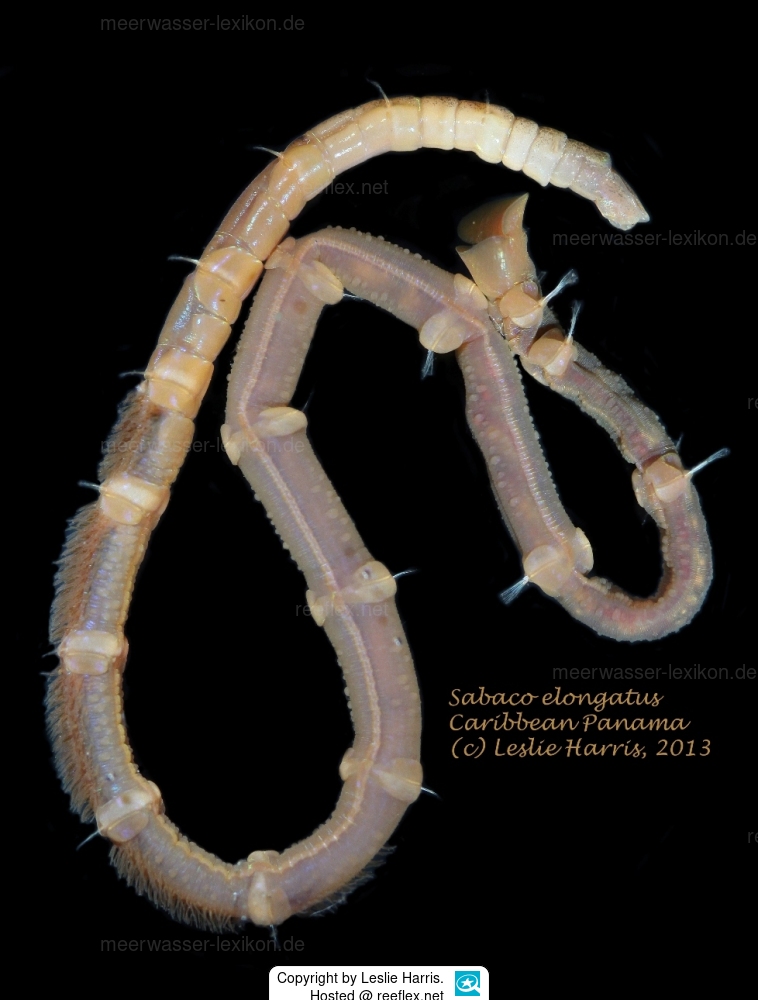Info
Sabaco elongatus (Verrill, 1873)
The type locality for description is Connecticut, USA.
Sabaco elongatus is a polychaete in the family Maldanidae and is called the “bamboo worm” due to its jointed appearance. Many segments of a maldanid worm's body contain neuropodial tori (or ridges containing small bristles) at their ends, reminiscent of a bamboo shoot.
Sabaco elongatus is a tube-dwelling polychaete commonly known as the elongated bamboo worm. It is native to the western Atlantic from the Gulf of St. Lawrence to Belize and was introduced in California. Populations have become established in San Francisco Bay. It is a detritus and all sorts of sediment eater. It is stuck upside down in a vertical tube of mud, sand and clay and can tolerate a wide range of temperatures from cold temperate to tropical conditions. No impacts have been reported for this species from its introduced range.
Description: Sabaco elongatus lives in a thick tube. Its body is slender and resembles a bamboo stick, with elongated body segments and poorly defined parapodia. The body consists of 22 segments, including a fused prostomium and peristomium, another segment without bristles, 19 bristle segments and a funnel-shaped pygidium (end). The animal's position is head down in its tube with the pygidium (rear end) protruding.
Specimens from San Francisco Bay ranged in size from 62 to 215 mm, from the Atlantic 150–300 mm and sometimes reaching 450 mm. The color is very variable, ranging from tawny, skin-colored, pink, reddish-brown, chocolate brown to dark gray, but usually with darker colors (bluish, purple, blackish) and an iridescent sheen on the front.
The tube is long and thick, made of black mud and clay, and often encrusted with sand.
Synonymised names
Asychis elongata (Verrill, 1873) · unaccepted (unused recombination)
Branchioasychis americana Hartman, 1945 · unaccepted (subjective synonym)
Branchioasychis colmani Monro, 1939 · unaccepted (subjective synonym)
Maldane elongata Verrill, 1873 · unaccepted (superseded original combination)
Maldanopsis elongata (Verrill, 1873) · unaccepted (superseded subsequent combination)
The type locality for description is Connecticut, USA.
Sabaco elongatus is a polychaete in the family Maldanidae and is called the “bamboo worm” due to its jointed appearance. Many segments of a maldanid worm's body contain neuropodial tori (or ridges containing small bristles) at their ends, reminiscent of a bamboo shoot.
Sabaco elongatus is a tube-dwelling polychaete commonly known as the elongated bamboo worm. It is native to the western Atlantic from the Gulf of St. Lawrence to Belize and was introduced in California. Populations have become established in San Francisco Bay. It is a detritus and all sorts of sediment eater. It is stuck upside down in a vertical tube of mud, sand and clay and can tolerate a wide range of temperatures from cold temperate to tropical conditions. No impacts have been reported for this species from its introduced range.
Description: Sabaco elongatus lives in a thick tube. Its body is slender and resembles a bamboo stick, with elongated body segments and poorly defined parapodia. The body consists of 22 segments, including a fused prostomium and peristomium, another segment without bristles, 19 bristle segments and a funnel-shaped pygidium (end). The animal's position is head down in its tube with the pygidium (rear end) protruding.
Specimens from San Francisco Bay ranged in size from 62 to 215 mm, from the Atlantic 150–300 mm and sometimes reaching 450 mm. The color is very variable, ranging from tawny, skin-colored, pink, reddish-brown, chocolate brown to dark gray, but usually with darker colors (bluish, purple, blackish) and an iridescent sheen on the front.
The tube is long and thick, made of black mud and clay, and often encrusted with sand.
Synonymised names
Asychis elongata (Verrill, 1873) · unaccepted (unused recombination)
Branchioasychis americana Hartman, 1945 · unaccepted (subjective synonym)
Branchioasychis colmani Monro, 1939 · unaccepted (subjective synonym)
Maldane elongata Verrill, 1873 · unaccepted (superseded original combination)
Maldanopsis elongata (Verrill, 1873) · unaccepted (superseded subsequent combination)







 Leslie Harris, USA
Leslie Harris, USA

